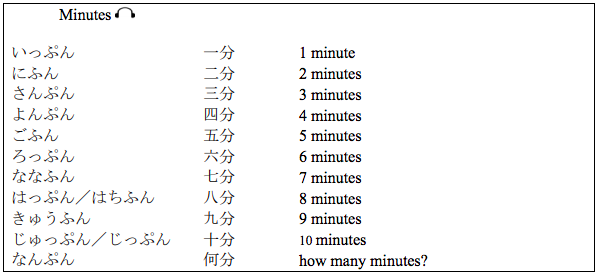2.1: Dialogue 1
- Page ID
- 31511
Michael: Minna de eiga ni ikimasen ka. Do you want to go see a movie with everyone?
みんなで映画 えいが に行い きませんか。
Honda: Ii aidea desu ne. Good idea!
いいアイデアですね。
After checking the show times
Michael: Shichi-ji Juu-go-fun no ga ii desu ne. The 7:15 one is best, isn’t it.
7時 じ 15分 ふん のがいいですね。
Honda: Ee. Ja, eki de roku-ji ni machiawasemashou. Yes. So, let’s meet up at the station at 6:00.
ええ。じゃ、駅 えき で六時 ろくじ に待 ま ち合 あ わせましょう。
Michael: Wakarimashita. Got it.
わかりました。
Vocabulary
minna de みんなで everyone together
eiga えいが 映画 movie
+eigakan えいがかん 映画館 movie theater
+umi うみ 海 ocean, sea
+yama やま 山 mountain
+onsen おんせん 温泉 hot spring ni に to (goal of motion)
+e へ to (direction of motion)
aidea あいであ アイデア idea
eki えき 駅 station
+basutei バスてい バス停 bus stop
~fun/pun 〜ふん/ぷん 分 minute (s)
ni に at (point in time)
machiawasemasu まちあわせます 待ち合わせます meet, rendezvous
machiawase まちあわせ 待ち合わせ get-together, date
+gozen ごぜん 午前 morning, a.m.
+gogo ごご 午後 afternoon, p.m.
Grammar Notes
Location Particles Ni and E
A place noun followed by particle ni or e, written as へ in Hiragana, indicates the ending point or direction of motion. The particles ni and e are typically used with motion verbs such as ikimasu, kimasu, kaerimasu. The difference between ni and e is subtle. Precisely speaking, ni assumes arrival at the goal while e indicates movement towards a place. But the two can be used interchangeably in many cases.
学校 がっこう に/へ行い きます。 Gakkou ni/e ikimasu.
I’ll go to school.
アメリカに/へ帰か えりました。Amerika ni/e kaerimashita. I returned to America.
Both ni and e can be used with other verbs indicating the direction or goal.
友 と もだちに/へメールします。Tomodachi ni/e meeru-shimasu. I’ll email my friend.
あの会社 かいしゃ に/へ紹 介 しょうかい します。Ano kaisha ni/e shoukai-shimasu.
I’ll introduce you to that company.
Some verbs can only take に. In the following examples, you can see that there are a number of ways that this particle might be translated into English.
ノートに書 か きました。Nooto ni kakimashita. I wrote it down in the notebook.
林 はやし さんに会 あ いましたよ。Hayashi-san ni aimashita yo. I met Ms. Hayashi.
エレベーターに乗の りましょう。Erebeetaa ni norimashou.
Let’s take the elevator.
先生 せんせい に聞 き きます。Sensei ni kikimasu. I’ll ask the teacher
〜fun/pun Naming and Counting Minutes
As we learn more time expressions, it’s important to understand the difference between expressions that name things and those that count things. Naming expressions include the days of the week (e.g. getsu-youbi), clock time (e.g. ku-ji), and classifiers such as ~ban, for example. Counting expressions include classifiers such as ~tsu, ~~ko, 23 ~mai, etc. Some classifiers are used for both naming and counting. ~kai for floors is one such classifier.
The classifier ~fun is for both naming and counting minutes. So, jup-pun can either mean ten minutes after the hour, (the point in time--naming), or ten minutes (the length of time --counting). For counting, ~funkan is sometimes used to avoid confusion. In telling clock time, the hour is followed by minutes (ku-ji jup-pun.)
Note the sound change of /f/ to /p/ in combinations with 1, 3, 4, 6, 8, 10 and in the question word nan-pun.

Time Particle に
A time expression with particle に indicates the time when something happens or happened. The particles は and も can be added to it.
日曜日 にちようび に帰 かえ ります。 Nichiyoubi ni kaerimasu. I’ll return on Sunday.
八時 はちじ には出で ましょう。 Hachi-ji ni wa demashou. Let’s leave at 8:00 (at latest).
十時 じゅうじ にも授 業 じゅぎょう があります。Juu-ji ni mo jugyou ga arimasu. I have a class at ten, too.
Two types of time expressions usually do not take the particle ni. One type includes relative time expressions such as kyou、ashita、ima.These expressions refer to different points in time depending on the time frame in which they are used. The other type includes vague time expressions such as asa、hiru、ban. These expressions refer to a period of time without a specific starting or ending point. Compare the following examples with those above.
今日 きょう 、帰 かえ ります。 Kyou kaerimasu. I’ll return today.
朝 あさ 、出で ましょう。 Asa, demashou. Let’s leave in the morning.
晩 ばん も、授 業 じゅぎょう があります。Ban mo jugyou ga arimasu. I have a class in the evening, too.


